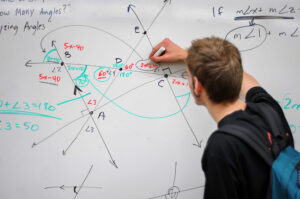The ACT is important to high school students in Missouri and across the U.S. for several reasons. It is an important factor that is considered in college admissions and how scholarships are awarded. It can help students become eligible for the A+ Scholarship and in some parts of the state it is a requirement to graduate. While the level of importance can differ among students, based on their plans, it is a tough challenge for everyone their first time. Students take timed tests in multiple subjects, answering questions that can confuse them or make them second guess themselves.
This is the second article of a four-part series on the ACT test, from Journey to College, describing each of the subject tests and how to prepare for them. In this article, the math section of the test is the subject of discussion.

The basics of the math test
Of all the subject tests, the math portion is the most straightforward. In an hour, you answer 60 problems. The questions get more difficult as you go, meaning the first question is the easiest and the last question is the most difficult. It mainly covers concepts from algebra and geometry. The last 20 questions pull from more advanced topics, such as trigonometry, pre-calculus, and calculus.
 How do I prepare for the test?
How do I prepare for the test?
The ACT publishes a test breakdown, which describes how much of the test is focused on one topic (modeling, preparing for higher math, etc.). In each topic, it is further broken down into certain types of questioning. For example, about 8-12 percent of the test will cover statistics and probability questions.
To help students prepare for the test, the ACT also provides old versions of the test online and in print. Ask your counselor if they have copies of old booklets so you can take practice tests and time yourself.
How is the test graded?
 The ACT has released its scoring rubric so you can know ahead of time what to expect. This is very helpful for students who are aiming for a specific score, such as those aiming to earn the A+ Scholarship. Students who didn’t score proficient or advanced on their Algebra 1 end-of-course exam can substitute an ACT math score to qualify. Depending on your GPA, this score can change. The same is true for students trying to earn scholarships from a university, especially with the superscore option now available.
The ACT has released its scoring rubric so you can know ahead of time what to expect. This is very helpful for students who are aiming for a specific score, such as those aiming to earn the A+ Scholarship. Students who didn’t score proficient or advanced on their Algebra 1 end-of-course exam can substitute an ACT math score to qualify. Depending on your GPA, this score can change. The same is true for students trying to earn scholarships from a university, especially with the superscore option now available.
Final thoughts
The math section of the ACT is meant to demonstrate the depth of your knowledge in the subject. You either know the material or you don’t. And that is OK. Every student will bring a different level of expertise, as well as a different desire, whether you are aiming for top marks and the Bright Flight scholarship, or just trying to make a certain threshold for A+. Remember, preparation is key.

